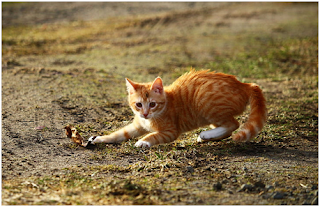What to Know About Pet Joint Health
Awesome article from Life's Abundance blog post from October 19,2020

Age is not a disease.
We say that all the time in medicine, because it’s true. “He’s slowing down” is an observation, but it’s not a diagnosis. All too many times, when I’m asking someone how their pet is doing they will say, “Well, he’s slowing down, but he’s old. What are you going to do?”
Lots! We have lots of things we can do, especially for one of the most common diseases of aging dogs and cats: degenerative joint disease (DJD), also known as osteoarthritis (OA). In fact, one out of five pets are experiencing this right now. And many of them could be feeling a lot better.
DJD is more complicated than it might appear at first blush, but it’s also one of the most gratifying to treat when you’re able to improve a pet’s quality of life so significantly. Whether you have a senior pet with diagnosed or suspected DJD, or a younger pet you want to keep in good health for a good long time, there are things you can be doing right now to maintain their joint health.
Anatomy of a Joint
Unlike a heart or a kidney, a joint is not a discrete organ but a term used to describe the connection between bones. Joints vary in terms of structure, function, and components. Your knee joint, for instance, is a back-and-forth hinge joint, while the joints that connect the bones in your skull move very little. In both cases, this is a good thing.
Joints have multiple components such as cartilage, connective tissue like ligaments and tendons, and capsules that enclose the joint and keep everything contained. Depending on where the joint is located, its purpose is to protect the bones, allow free movement by reducing friction, and act as a cushion.
Cartilage is a critical tissue in the joint. It is comprised of cells called chondrocytes suspended in a matrix of collagen and proteoglycans, which trap water and keep the cartilage nice and plump. Healthy chondrocytes keep that matrix fully hydrated, which is essential for the joint’s ability to absorb forces without damage. Cartilage creates the joint cushion.
The synovial membrane is the tissue that surrounds the joint and keeps it sealed. The membrane secretes synovial fluid into the joint, which is critical for lubrication.
If there is any disruption to the cartilage, the synovial membrane, or the bone underneath the cartilage, your dog or cat can begin to develop a joint disease.
Causes of DJD
While DJD can result from the normal aging process, it is often accelerated in pets by an injury or other underlying health condition that causes stress or inflammation. Inflammatory compounds in the joint space disrupt the cartilage matrix, reducing its ability to retain water. As the cartilage dehydrates, it starts to become more brittle and rubbery, like a piece of cheese you left out overnight. It also becomes more likely to splinter. If it gets bad enough, the underlying bone can also be affected.

Treatment and Prevention
Unfortunately, DJD in dogs and cats is an irreversible process. Treatment is aimed at slowing down the progression of the disease, reducing pain, and maintaining movement in the joint. It is a complex process with a lot of different elements, which means one thing: the best treatment hits the disease process on multiple fronts. We call this ‘multimodal disease management,’ and it’s the gold standard in DJD therapy. Here are the different fronts from which we attack DJD:
1. Anti-inflammatories. Remember when I mentioned those inflammatory compounds? There are a lot of them. No one medication or supplement gets them all, which is why we tend to combine them for better results.- NSAIDS- These are the most recognizable of the bunch for most of us, and are nice because they reduce both inflammation and pain. In pets, these are prescription meds such as Rimadyl, Metacam, or Deramaxx. Please don’t use over the counter people medications like Advil or Aleve- they simply aren’t as effective and can be dangerous to your pets.
- Nutraceuticals and supplements- This is an ever-expanding group of treatments that gets lots of attention for being effective across many species, with a low incidence of side effects. The most recognizable names here are glucosamine/ chondroitin sulfate, but newer players on the market such as green lipped mussels are also giving great results.
- Adequan injections- This is an injection available through veterinarians that stimulates the cartilage to improve the matrix.
2. Weight loss. If your pet is overweight- which describes about half the pets in the US! -this can accelerate the stress that causes cartilage to degenerate. If your pet is overweight, talk to your vet about what their ideal body weight should be. If they are the correct weight, well done! Keep it up.
3. Alternative treatment modalities. I trained and became certified in veterinary acupuncture specifically to treat arthritic pets, with good results. I’ve also used lasers, a product that uses pulsed electromagnetic fields, and physical therapy. The more layers you add onto your treatment, the better the results.
4. Prevention. Unfortunately, by the time a pet starts to limp or shows signs of pain, they have usually had DJD for some time and it is fairly advanced. That’s why preventive measures are so important. Here’s what pet owners should do from the get-go:
- Maintain a healthy weight for your pet.
- Maintain a regular exercise program to keep joints mobile and healthy.
- Keep your pet on a healthy diet and add omega-3 fatty acids, which have anti-inflammatory properties.
- If your pet is highly active or in a higher-risk category for DJD, consider adding nutraceuticals and supplements to their diet sooner rather than later.
Age isn’t a disease, but DJD is. It’s not often I say, “the more the merrier!” when it comes to treatments, but in this case you really can’t begin joint healthcare early enough. From diet to exercise to supplements, put your plan in place now to keep your pet in good health long into their senior years!
Wishing you and your family health and happiness,
Dr. Jessica Vogelsang, DVM

